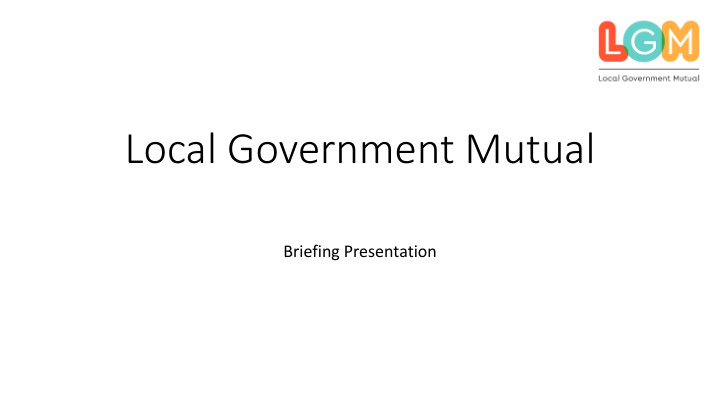



Local Government Mutual Briefing Presentation
Introduction • Councils collectively spend many hundreds of millions annually on insurance • Many councils have substantial self insured retentions, with data indicating they are paying the cost of circa 85% of claims themselves • Some councils have significant self insured aggregate retentions – which have the potential to deliver volatility to their balance sheets • Councils can typically strike a much keener bargain with the insurance market collectively, than would be expected individually • The sector has the ability to retain more risk collectively, whilst containing or reducing it individually • Retaining any surplus generated and using it solely for the benefit of its members, not third party shareholders
The Local Government Mutual • Pooled retention in the mutual pays for ‘expected’ claims • ‘Unexpected’ claims (individual and accumulations) transferred to insurers • Members pay contributions based on their own unique risk profile • Contributions are used for the payment of: • Retained claims • Excess and aggregate insurance • Administration costs • Surplus can only be used for the benefit of members • Owned entirely by its members • Controlled by a Board of Directors drawn from within the membership • Income retained in the mutual is not subject to insurance premium tax
Aims of the Local Government Mutual • Provide cost effective risk transfer (with no profit mandate) • Reduce the Total Cost of Risk, releasing funds for services • Reducing the direct and indirect costs of losses • Deliver transparency and minimise frictional costs • Work collaboratively to improve risk management • Sustainability through managed level of mutual risk retention • Robust and proportionate governance and compliance processes • Enables members to benefit from mutual trading surpluses
Structure and procurement of insurance • The Mutual is a hybrid-discretionary mutual, not an insurance company • Contributions are bespoke, based on each local authority’s risks and claims performance • Members are protected by two elements of ‘wrap-around’ insurance • Excess of loss cover – above the mutual’s retention • Aggregate stop-loss cover – protecting the mutual’s retention against an unexpected accumulation of retained claims • Members have no exposure to an additional call
Structure a and p procurement o of i insurance Insurance policy • Mutual retained exposure is fully Individual Losses above £X per claim Covers losses above £X per claim funded from operational revenue • Financial statements prepared in Mutual Retention accordance with FRS 102 & 103 Insurance Policy The first £X of one loss Drop Down in the name of the mutual With a maximum of £Y • Maximum retained exposure, Losses beyond £Y per year during any one policy minus actual claims & IBNR period determines annual surplus quantum Member Excess Accumulation of retained losses beyond £Y during the policy period
Update on the project • 14 local authorities with LGA have contributed to a steering group which oversaw • Incorporation of the mutual • Appointment of Directors • Brian Roberts (CIPFA Past President) • Ian Rogers (Chief Actuary at Government Actuary’s Department) • Roger Houston (Specialist in Public Sector Insurance Claims) • The adoption of an initial Memorandum & Articles of Association • The appointment of a management company • OJEU procurement of mutual manager • Local Government Mutual Management Services • A joint venture between LGA Commercial Services and Regis Mutual Management • Service assurance and contract oversight are independent of the JV • FCA authorisation • OJEU procurement of insurer panel • DPS framework released and populated with a panel of insurers • Supplemented by access to YPO insurance placement DPS
Membership • LGA members • 12 month periods • Owned by member authorities so exempt from EU Public Contract Regulations (Teckal exemption) • Business case process, reliant on usual disclosures • Ownership & Control delivers complete transparency • Cabinet report from council’s chief finance officer
Operations • In-house claims team • Active account management • Risk & Insurance Managers – key role in loss reduction and risk management • Covers include: • Property • Liability • Construction • Engineering • Management liability • Motor • Personal accident
Risk management • Key to mutual’s success • Members benefit directly from the loss reductions that flow from effective risk management • Member-driven – the mutual acts as a clearing house • Controlled within authorities by Risk & Insurance Managers, or other nominated officer, where possible • Supports identification and sharing of best practice, drawing on LGA’s Sector Led Improvement capability. • Mutual provides its members with claims trends analysis, route cause analysis, lessons from losses, anonymised benchmarking, full risk management reports (including insurer MFL & PML calculations to assist with setting loss limits)
Corporate Governance • Board drawn from and accountable to the membership • Adheres to the Association of Financial Mutuals’ annotated version of the UK Corporate Governance Code • Satisfies Public Contract Regulations control requirements for a ‘Teckal’ company.
Current activity and next steps • OJEU tender completed (DPS remains open) • We are currently engaging with 55 councils (as at 22-Feb, as at 18-Aug, approaching 100) • 8 metropolitan councils • 7 unitary councils • 1 county council • 39 district councils • Engaged local authorities are at different stages of the business case process • Events and PR activity to engage all LGA member councils • Open for business from April 2019.
Local Government Mutual
Recommend
More recommend